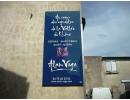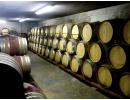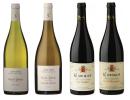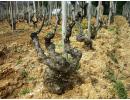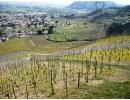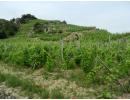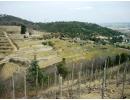Alain Voge
Cornas / Saint-Peray - Rhône Valley
![]() Certified Organic since 2009 for the whites / since 2016 for the reds
Certified Organic since 2009 for the whites / since 2016 for the reds
Alain Voge “Ongrie” 2015 - Saint Péray
A wine made with Marsanne from a 1.5 ha parcel located at the lieu-dit “Hongrie”. The parcel is set at the foothills where the soil structure is composed of granite, clay and limestone elements. The 50 year old vines produce a yield of 40 hl/ha. The wine is barrel fermented for 2-3 months and aged for 13 months on fine lees with 30% of new oak barrels.
PVins notes: It is usually lightly toasted in style when young, with hints of white peach and white flowers with notes of tropical fruits. The palate is medium-bodied and shows subtle minerality with a clean and fresh finish. To be consumed over a period of 5-7 years. The wine used to be known as "Terres Boisées".
Wine Advocate 93
I had a slight preference for the Ongrie (formerly known as Terres Boisées) over the Fleur du Crussol. The 2015 Saint Peray Ongrie offers notes of toasted hazelnuts, Golden Delicious apples, cinnamon, clove, and baked pineapple. It's full-bodied, complex and flavorful yet finishes with a burst of fresh citrus and brine. Drink 2018 - 2022
Jeb Dunnuck 95
A new cuvée, the 2015 Saint-Péray Ongrie is made from 100% Marsanne and was brought up in 30% new French oak. It offers a more almond paste, toasted nut and orchard fruit-scented bouquet, with a gorgeously rich, elegant texture. Full-bodied, fresh and elegant, with beautiful purity and freshness, it’s undoubtedly the finest white I've tasted from this estate to date.
Decanter 94
St Péray is often overlooked in the line-up of Rhone appellations, and wrongly so, especially in the hands of Alain Voge. He explained that he works 'à la bourguignonne' - he ages the wine for 13 months, and aims to bring out what he calls the 'côté minérale' of the wine, with its saline notes. I found it elegant and refreshing, with a distinctive salty note. Drink 2017 - 2020
Bettane & Desseauve 16.5
Powerful at the beginning of the palate, with a superb mineral expression specific to the terroir, tasty, lean, with a good retro-olfaction of gourmand white fruit. Drink 2017 - 2025
Alain Voge “Fleur de Crussol” 2015 - Saint Péray
A premium wine made with Marsanne from a 1.5 ha parcel located at the lieu-dit “La Côte”. The parcel is set on a slop where the soil structure is composed of granite with colluvial limestone deposits. The 80 year old vines (oldest in the appellation) produce a low yield. Follwoing the fermentations in barrels for 2-3 months, the wine is aged for 16 months on fine lees in barrels of 228 litres and demi-muids of 400 litres with 30% of new oak.
PVins notes: Light yellow in colour, a complex floral nose with hints of exotic fruits. Full-bodied richeness and texture balanced by a minerally freshness, a lengthy complex aromatic finish. May be cellared for up to 10 years.
Wine Advocate 92
The barrel-fermented Marsanne 2015 Saint Peray Fleur de Crussol is a toasty wine, loaded with roast cashew notes and grilled pineapple. Full-bodied, broad and flavorful, it's a concentrated wine that coats the mouth with honeyed richness, lingering on the finish. Drink 2018 -2022
Wine Spectator 93
This has a flattering display of creamed melon, pear and peach flavors gliding along, lined with hazelnut husk and salted butter notes that add range and length through the finish, with long honeysuckle and heather echoes. Drink now through 2022.
Jeb Dunnuck 93
I always love this cuvée, and the 2015 Saint-Péray Fleur De Crussol might be the best yet. Brioche, honeycomb, crushed rock-like minerality and sautéed stone fruits give way to a rich, concentrated, beautifully textured white that has richness and freshness. Made from 100% Marsanne all from the La Côte lieu-dit, it spent 13 months in 30% new barrels.
Vinous.com 93
(from the estate’s oldest vines; aged for 16 months in 400-liter oak barrels, one-third of them new) Light vivid yellow. Nervy, mineral-accented orchard and pit fruit aromas show excellent clarity, and a suave floral element emerges slowly. Sappy, palate-staining pear nectar and white peach flavors are complicated by notes of violet, honey and orange pith. A minerally element adds vibrant lift and drives the finish, which hangs on with superb tenacity and a repeating floral quality.
La Revue du Vin de France 16.5
Alain Voge “Les Chailles” 2013 - Cornas
This is the entry level wine of the Domaine made from 30 year old Syrah. The 2 ha parcel planted on granite schist is mainly located at the lieux-dits “Chaillot” and “Les Reynards”. The average yield is 37 hl/ha. The grapes are destemmed, the fermentations are carried out is small stainless steel vats at 30°C for 3-4 weeks. Ageing will last 16 months in french oak barrels without any new oak.
PVins notes: Don’t be miss guided by the notion of entry level wine, it offers great aromatic complexity, the tannins are smooth and the acidity is never too high. It will age over 8-15 years depending on the vintage
2013
Wine Advocat 90
The 2013 Cornas les Chailles is the estate’s entry level wine that comes all from the Les Chailles lieu-dit, which is located in the northern part of the appellation. This 2013 offers outstanding notes of black and blue fruits, pretty wild herbs, violets and plenty of minerality. Medium to full-bodied, pure, and with fine tannin, it doesn’t have a huge back-end level of depth or concentration, but it’s a beautiful wine that will have a decade of drinkability. Drink 2015-2025
Wine Spectator 93
A focused, chalk-edged style, with piercing savory and olive notes out front, backed by red currant and bitter cherry flavors. The racy, mouthwatering finish allows the chalky spine to stretch out. Will be a winner when the fruit fills out fully. Best from 2017 through 2027.
Vinous.com 92
Opaque ruby. Vibrant and sharply focused on the nose, displaying intense dark berry and floral scents complicated by suggestions of olive, pungent flowers and smoky minerals. Juicy, concentrated and gently sweet, offering sappy cherry and black currant flavors that become more lively and spicy with air. Shows excellent power and spicy thrust on an impressively long, youthfully tannic finish, leaving notes of dark berry liqueur and allspice behind. Drink 2020 - 2026
Alain Voge “Les Vieilles Vignes” 2015 / 2009 - Cornas
This is the main wine of the Domaine made with Syrah. The old vines are at least 30 years old from various parcels representing 3.50 ha in total, located on decomposed granite known as “gore”. The average yield is 35 hl/ha. The grapes are destemmed, the fermentations are done in small stainless steel vats lasting 3-4 weeks at 30°C. The wine is aged in french oak barrels for 18-20 months with 20% of new oak.
PVins notes: This dark coloured wine offers an excellent complexity of aromas and flavours. The palate shows great quality tannins and concentration that need to smooth out with a little cellaring over 3-4 years on release, the finish just lingers on. The wine will evolve over 20-30 years depending on the vintage.
2015
Jancis Robinson 17.5
What a tremendous nose! Combines floral and meaty notes with piquant spice and loads of dense black fruit. Bursting forth with flavour, yet with a frame of acid and tannin that gives superb grip. Perhaps just slightly simple to finish – but more will surely come. Drink 2018 - 2035
Wine Spectator 95
Rich, deep and layered, the 2015 Cornas Vieilles Vignes has it all. Big fruit allied to spicy complexity? Check. Ample tannins that are fully ripe? Check. A finish that extends for days? Check. Oh, you want details? Hints of brown sugar, savory spices and roast meat accent black berry and plum fruit, and while the mid-palate is dense and tannic, those tannins actually turn more supple and approachable on the lingering finish. Drink 2020 - 2035
Vinous.com 94
Brilliant purple. A highly perfumed bouquet displays ripe, mineral-tinged black and blue fruit, potpourri and incense qualities. Fleshy and expansive on the palate, offering densely packed yet energetic boysenberry, candied licorice and violet flavors enlivened by an undercurrent of juicy acidity. Smoothly blends richness and finesse and closes extremely long and youthfully tannic, leaving behind sexy floral pastille and dark berry liqueur notes. Drink 2024 - 2032
Bettane & Desseauve 18
The richest of them all, chocolaty tannins, particularly refined, beautiful freshness on the finish, superb! Drink 2020 - 2035.
2009
Wine Advocat 96
Much more voluptuous and sexy than the more backward 2010, the 2009 Cornas Vieilles Vignes knocks it out of the park with its toasted spice, black raspberry, licorice and graphite-laced bouquet. Thick, full-bodied, and concentrated, with a wealth of raw material, as well as a lashing of tannin, give this blockbuster 2009 a handful of years in the cellar and enjoy through 2035.
Wine Spectator 94
This is loaded with vivacious character, as a lively briar note punctuates the grippy charcoal, sweet tapenade, blackberry coulis and macerated plum fruit flavors. The long, iron-driven finish lets the fruit play out.
Jancis Robinson 17.5
Alain Voge “Les Vieilles Fontaines” - Cornas
The flagship cuvée “Old Fountains” made with Syrah is only produced in excellent vintages. The vines are on average 80 years old, the 1 ha parcel is planted on granite. The average yield is 30 hl/ha. The grapes are destemmed, the fermentations are carried out is small stainless steel vats at 30°C for 3-4 weeks. The ageing in 225 litres french oak barrels will last 24 months with 25% of new oak.
PVins notes: This dark purple coloured wine offers an excellent complexity of aromas with multi-layered flavours. The palate is full-bodied with great quality tannins and extraction, a little more concentrated then the “Vieilles Vignes”, it needs 4-5 years cellaring after release to soften the tannins and the finish is very long. The wine is an outstanding example of the Syrah on this type of terroir. The wine will evolve over 20-30+ years.
The family VOGE has been in Cornas for many generations. In 1958 Alain VOGE, 4th generation, joined his father on the estate when the appellations Cornas and Saint Péray were at the time not very active. Alain decided to replant the slopes that had been abandoned for the last 30 years and to “estate bottle” the wines. Alain and his wife Elaine inherited the domaine from his father at a time when it was hardly worthwhile to harvest the grapes. After World War II a bushel of local peaches was worth more than a case of Cornas, so Alain supplemented his income by farming fruits and vegetables in the plains. Alain stubbornly tended the vines and made the wines regardless of its market value and it was not before the mid-1980s that producing Cornas became truly economic. By then the Domaine Alain Voge was producing high quality wines becoming the reference in the appellation with International critics such as Robert Parker describing the wines as “some of the best in the world”.
In 2004 following some serious health issues for Alain Voge, Albéric Mazoyer (ex-Michel Chapoutier cellarmaster for numerous years) joined the Domaine Voge to manage it, but Alain is never far away. Alain excelled in conventional grape-growing and Albéric had to convince him to convert to biodynamic. In 2006 the organic conversion was fully implemented, resulting in the first biodynamic certification for the whites of Saint Péray in 2009. In 2013 the Domaine Voge has gone a step further by implementing biodynamic farming to the whole Domaine. Albéric has now been managing the estate for several years and has taken the Domaine to a new level of outstanding quality.
French Version
Today Domaine Alain Voge covers 13 ha with 7 ha in Cornas made up of numerous parcels of Syrah and 4 ha in Saint Péray planted in 95% Marsanne and 5% Roussanne. Most of the vines are 50+ years old, meaning that virtually all of Voge's production could be labeled “Vieilles Vignes” (old vines).
The vines in Cornas are planted on steep slopes, a bit like Côte Rôtie further north, facing south and south-east on a dense granitic schist terroir giving the wines a more subtle elegance on the palate compared to some northern Rhône appellations. Since 2005, the Domaine also produces a red Saint Joseph further north, a 1 hectare parcel of young vines on the commune of Mauves south of Tournon.
As for Saint Péray the vines are planted on gentle slopes either facing south at the parcel “Les Côtes” or south-east at the parcel “Hongrie” with various terroirs of clayey-limestone and granite with limestone colluvial deposits. The 80 year old Marsanne from the lieu-dit "Hongrie" are the oldest of the appellation.
In 2006, the organic conversion was fully put into place by Albéric (ex-Chapoutier winemaker) as the new manager of the Domaine resulting in the first organic/biodynamic certification for the whites of Saint Péray in 2009. Since 2013, the Domaine Voge has gone a step further by implementing biodynamic farming to the whole Domaine.
The harvest is done manually at full maturity, a first selection is done in the vineyard and a second selection of bunches is carried out at the cellar. For the reds a percentage of whole bunches will be used in the winemaking process depending on the vintage. Small 30-50 hectolitres stainless steel vats are used for the vinification of the reds and the white “Harmonie”, while the other two whites are barrel fermented at cellar temperature over 2 to 3 months. All the wines are aged in oak barrels (except “Harmonie”) of 228 litres and 400 litres demi-muid with different percentages of new oak and duration depending on the strength of the wine and quality of the vintage.
Globally the wines are not really marked by the oak as it is well managed, it is about giving just a touch of extra structure and aromatic complexity to the wines. The reds are deeply coloured and aromatically complex. The flavours are dense and layered with fully integrated, ripe tannins promising tremendous ageing potential especially in great vintages. As for the whites they show ample tropical fruits, as well as a good minerality and floral aromas. The palate is medium to full-bodied depending on the wine, there is richness and freshness.
Voge produces three Cornas “Les Chailles”, “Les Vieilles Vignes” and the special premium cuvée “Les Vieilles Fontaines”, which is only produced if the vintage permits it from a parcel of 85 year old vines facing south on a steep slope. Here the vines go deep in the poor granitic soil.
For the whites four Saint Péray are produced, one sparkling "Les Bulles d'Alain" and three still whites “Harmonie”, "Ongrie” (ex-Terres Boisées) created in 1984 and a premium “Fleur de Crussol” created in 1999 made from 80 years old vines planted on a hillside set on granite with limestone deposits.
Links: AOP Cornas - AOP Saint Péray - Northern Rône map
CORNAS
The appellation Cornas, meaning "Terre Brulée" Burnt Earth in celt, was created in 1938, it is located in the northern Rhône on the right bank of the Rhône River about 7 kilometres west of the city Valence.
History
The vineyards of Cornas are very old, the first terraces and “chaillées” (walls) were likely made by the Romans. The first written evidence of Cornas wine can be found in the 10th century, when a canon from Viviers mentioned the church in Cornas that was surrounded by vines and various French Kings were known to love the wine from Cornas.
Vineyard
Only Syrah is grown here and the appellation accounts for 128 hectares. The vineyard sits on the eastern slopes of the mountain chain “Massif Central” at 200 to 300 meters in altitude, planted on craggy slopes which have been cut into narrow unstable terraces known locally as “chaillées”. The abrupt south and south-east facing slopes form a natural amphitheatre that protects the vines from the northern cold winds in winter and the strong southern wind “Mistral” but in general the climate is Mediterranean influenced. The terroir is mainly made up of decomposed granite, resulting in clay like sands known as “gores”, silt deposits from the Rhône are found at the foothills and some limestone is found to the north and south of the appellation. The vines mature early here which is why this appellation is the first red appellation to be harvested in the northern Rhône about a week before the others.
A Cornas is a very dark red wine almost black with purplish tints when young and becoming amber with age. It is one of the most robust French wines as the terroir brings out its strength and richness eventhough in recent times some winemakers have been producing wines with rounder tannins. The wines age very well, with time their tannins become smoother. The Cornas aromas are black fruits, spices, licorice and hints of cocoa when young and evolve with cellaring into aromas of leather, musk, pepper and truffles.
SAINT PERAY
The appellation Saint-Péray created in 1936 is located south of Cornas and it is the most southern appellation of the northern Rhône region. The appellation was named after the nearby village of the same name. Its original name was Saint-Pierre-d’Ay which later became “Saint-Péray”.
History
Saint-Péray is well known for its “Château Crussol” built in the 12th century using the local limestone, it seats on top of the mountain “Massif de Crussol” which is a limestone spur. In the 15th century villagers ventured outside the walls of the Château to settle the Mialan valley down below and cultivate vines. The 19th century marked the peak of Saint-Péray wines’ popularity as they were enjoyed throughout Europe by various rulers of the day from the Russian Tsars to Queen Victoria. In 1829 Louis-Alexandre Faure, a winemaker in the appellation, produced the first Saint-Péray sparkling wine inspired by the methods used in Champagne, today 1/3 of the wines produced in the appellation are sparklings.
Vineyard
The appellation covers 75 hectares, the only two grape varieties allowed are Marsanne and Roussanne with Marsanne being the dominant varietal. The terroir is complex from the various geological eras on which the vineyards are planted. The vines planted at the foothill of the “Massif de Crussol” have a north-west orientation set on a limestone soil structure dating from the Jurassic era. Those planted in the continuity of the Cornas appellation face south - south-east set on a granite based soil, a result of volcanic magma of the Massif Central from the Primary period. Some clayey-limestone deposit can also be found in the area. In more recent times during the Quaternary period and the major glaciations, fine particles carried by the wind also formed a veneer of loess and finally the terroir’s diversity was sealed by the Rhône River itself, with alluvial deposits carried downstream from the Alps.
The still wines are subtle, fresh, balanced and aromatic, not overly acidic and offer floral aromas of acacia, honeysuckle with hints of quince, dried apricot, peach and honey, vanilla and toast aromas may show when the wine has had oak treatment.
Climate
As for the climate, its uneven hillsides and the deep Mialan valley promote a cool micro-climate, the area is also more exposed to the northern winds within a generally hotter continental region, the freshness seems to be suiting the Marsanne and Roussanne quiet well.



